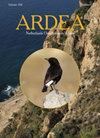Great Cormorants Phalacrocorax carbo in the Subalpine Soča River System, Slovenia: The Possible Effect of Avian Predators in a Sensitive Biogeographic Region for Fish
IF 1.3
4区 生物学
Q3 ORNITHOLOGY
引用次数: 1
Abstract
The foraging of Great Cormorants Phalacrocorax carbo in Alpine rivers is a relatively recent phenomenon. Wintering populations in Slovenia increased in the 1980s. In the 1990s, the increase affected the upper sections of rivers where the habitats of Grayling Thymallus thymallus and trout Salmo and Oncorhynchus spp. are located. The upper section of the Soča River system is known as one of the biogeographic hotspots for (sub)alpine rivers, where several endemic or rare fish species are found. The aim of this study is to evaluate the diet of the Cormorants in this area and to compare it to some other threats to the fish fauna of the river. A total of 75 Cormorant stomachs were examined. Of these, 68 (90.7%) contained fish or recognisable fish remains. The birds' diet consisted of eight species of fish: Marble Trout, Rainbow Trout, Common Nase, Vairone, Common Chub, Italian Chub, Italian Barbel and Bullhead. The increase in numbers and the diet of Cormorants in the river basin of Soča is discussed in the context of the increase of other threats to this ecosystem, such as fish stocking, gravel extraction and tourism, especially angling and water sports. A more comprehensive environmental assessment of all these factors is needed, as their increase runs parallel with the arrival of the Cormorants in the upper section of the river. There is therefore reason to believe that Cormorants are only a small part of a larger problem in the conservation of the river ecosystem.斯洛文尼亚亚高山so河系统中的大鸬鹚:鸟类捕食者在一个敏感的生物地理区域对鱼类的可能影响
大Cormorants Phalacrocorax carbo在阿尔卑斯河中觅食是一种相对较新的现象。斯洛文尼亚的越冬人口在20世纪80年代有所增加。在20世纪90年代,这种增长影响了Grayling Thymalus thymalus和鳟鱼Salmo和Oncorhynchus spp.栖息地所在的河流上游。Soča河水系的上段被称为(亚)高山河流的生物地理热点之一,在那里发现了几种特有或稀有的鱼类。本研究的目的是评估该地区Cormorants的饮食,并将其与该河鱼类群面临的其他威胁进行比较。共检查了75只Cormorant的胃。其中68个(90.7%)含有鱼类或可辨认的鱼类遗骸。这些鸟的饮食包括八种鱼类:大理石鳟鱼、彩虹鳟鱼、普通鼻鱼、瓦伊龙鱼、普通Chub、意大利Chub、意式Barbel和牛头鱼。Soča河流域Cormorants数量和饮食的增加是在该生态系统面临的其他威胁增加的背景下讨论的,如鱼类放养、砾石开采和旅游业,尤其是钓鱼和水上运动。需要对所有这些因素进行更全面的环境评估,因为它们的增加与河上游的Cormorants的到来平行。因此,有理由相信,在河流生态系统的保护中,珊瑚虫只是一个更大问题的一小部分。
本文章由计算机程序翻译,如有差异,请以英文原文为准。
求助全文
约1分钟内获得全文
求助全文
来源期刊

Ardea
生物-鸟类学
CiteScore
2.10
自引率
0.00%
发文量
49
审稿时长
>12 weeks
期刊介绍:
Ardea is the scientific journal of the Netherlands Ornithologists'' Union, and is published since 1912. The journal welcomes manuscripts reporting significant new findings in ornithology, in particular those covering the ecology, life history, and evolution of birds, and including sound descriptive work. Ardea publishes Original research papers, Short notes and Book reviews. In addition to the regular three issues per year, Ardea publishes specials that contain conference or workshop proceedings (produced on request).
 求助内容:
求助内容: 应助结果提醒方式:
应助结果提醒方式:


